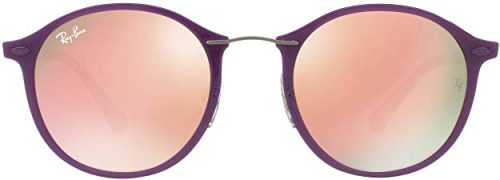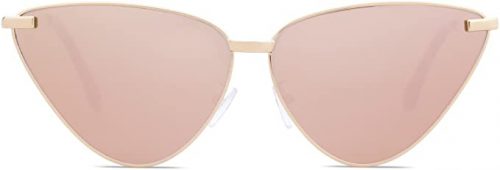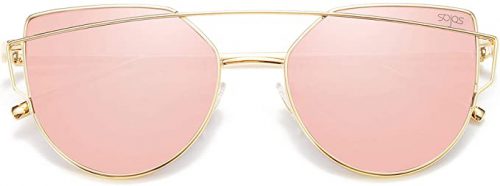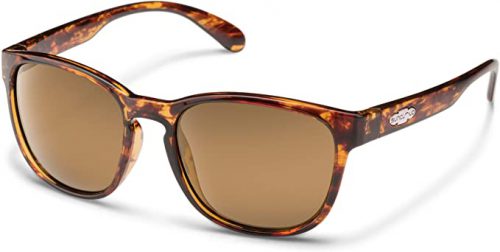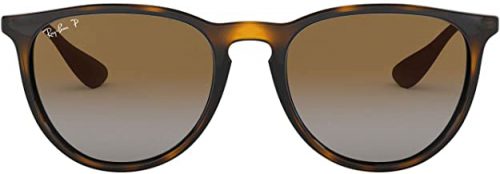Table of Contents:
Mirrored Sunglasses
Mirror sunglasses differ from normal colored or polarized sunglasses in terms of their performance and appearance. But, like polarized lenses, mirror lenses offer wonderful eye protection by preventing eye strain.
Mirror lenses, also called flash coatings, limit the amount of light that reaches your eyes, making you feel more comfortable.
The Advantages Of Mirror Sunglasses
Mirrors are highly reflective coatings that are applied to the outside of the sunglasses to reduce the amount of light that reaches the eyes. This makes them especially advantageous for activities in very bright conditions, such as skiing on a sunny day. Sunglasses with mirror lenses also have a coating that makes them more durable. On the other hand, they run the risk of color falsification. Another important aspect is the look, a pair of mirror sunglasses is so chic and cool that makes you look stylish even if you wear in combination with a pajama.
What Do We Need To Know About The Anti-Reflective Coating?
Another term that is often mentioned in connection with mirrored sunglasses is that they have “anti-reflective lenses”, which raises the question: “Aren’t the other lenses also anti-reflective lenses?”
Well, on the front of the lens, they are. When wearing sunglasses, the reflections are mainly stopped by the color shade on the front of the lens. However, on the back of the lens you need help from an anti-reflective (AR) layer. AR reduces the reflected light behind the sunglasses lens. Otherwise, the light will return to your eyes and interfere with your vision.
Polarized Sunglasses
What Are Polarized Sunglasses?
Certain daily outdoor activities, such as driving, expose your eyes to the blinding glow of light. To protect your eyes in such situations, the ophthalmologist recommends wearing polarized sunglasses.
Many people know that polarized sunglasses offer a higher degree of protection than regular sunglasses, but they do not know how polarized lenses work.
Polarized sunglasses work based on a process that many of us have learned in physics classes – the polarization of light.
Natural light or light from various sources such as light bulbs is unpolarized, it is spread in all directions. Therefore, when it touches a mirror-like surface, it is reflected to the human eye at a higher intensity, with a dazzling glow.
Polarized lenses are composed of a laminated filter, which absorbs horizontal light and allows only vertical light to pass through the lens. Thus, they reduce the brightness caused by the reflection of light on various surfaces, such as water, snow, ice or asphalt.
Prolonged exposure to blinding light can cause eye conditions such as cataracts over time. To avoid such complications, wear polarized sunglasses, especially when you do outdoor activities that require your eyes.
What is the polarization effect? – Non-polarized light waves are emitted both horizontally and vertically. Polarization of light is the phenomenon by which light waves are reduced to a single plane, so they become less annoying to the human eye.
What Is The Difference Between Polarized And Non-Polarized Sunglasses?
Any ophthalmologist can assure you of one thing: sunglasses with polarized lenses are better than normal sunglasses, because they protect the eyes from two points of view.
Non-polarized sunglasses only have a UV protection filter, while polarized sunglasses have a polarizing filter and can also have a UV filter.
Moreover, non-polarized sunglasses only reduce the amount of light that reaches the eyes, while polarized lenses absorb light, not just filter it.
What are the advantages of polarized sunglasses?
Polarized sunglasses look like any other pair of sunglasses on the outside.
But when you put them in your eyes, you will immediately see what is different about these lenses: they have a special film that blocks the horizontal rays of reflected light and allows the vertical light to pass to your eyes. Vertical light brings clarity and contrast to the environment, which results in clear vision and pure color.
Above all, however, the limitation of blinding light is the most visible feature of polarized lenses. They effectively block strong glare and surface reflections, which becomes especially evident when we look at water, for example.
The anti-glare properties penetrate all the concentrated sunlight that is reflected from the surface of the water so that you can see below the surface of the water. If the water is clear, you may also see fish and other marine life.
How Do I Know If My Sunglasses Are Polarized?
If you want to know if sunglasses are polarized, you can find out in three simple steps.
– Set the computer screen to the brightest mode and open a white screen.
– Put on your sunglasses.
– Tilt your head 60 degrees to the left or right. If the sunglasses are polarized, the screen will become darker due to the anti-glare properties that cancel each other out.
If one side does not work, try tilting your head to the other side. If this does not work, the sunglasses are not polarized.
